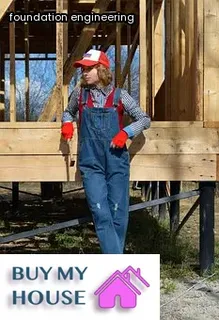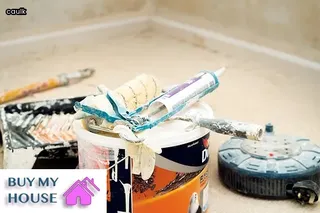Identifying hairline foundation cracks in your home can be a daunting task. It's important to know the difference between normal shrinkage cracking and structural damage, as well as how to repair them.
Hairline cracks are typically caused by normal settling of a house, but they can also be indicative of more serious problems like foundation settling or hydrostatic pressure from soil moisture. It is important to inspect the outside of your home for any visible signs of foundation damage, such as horizontal or stair-step patterns in mortar joints, bulging walls, or cracking bricks.
Inside the home, you may notice buckling walls or doors that don't close properly. Additionally, hairline cracks may appear around windows and door frames which could be an indication of shifting foundations.
To diagnose any underlying issues, it is advised to contact a qualified professional who can assess the situation and recommend needed repairs.

Foundation cracks can be a sign of serious structural damage, so it's important to understand the different types of foundation cracks and how to repair them. Vertical cracks in the foundation are usually the result of ground movement or settling of the soil around your home.
Horizontal cracks may indicate hydrostatic pressure from water buildup in the soil around the foundation walls. Stair-step or diagonal cracks are often caused by uneven settling on one side of your home and can occur when there is inadequate support for part of your foundation wall.
Knowing how to identify each type of crack will help you determine which repairs are needed and how urgent they may be. Some minor hairline or shrinkage cracks can be filled with caulk, but larger vertical, horizontal or stair-step fractures require more extensive repairs such as epoxy injection, steel reinforcement bars, underpinning and even replacement sections.
Professional assessment is recommended to determine which repair method is best suited for each type of crack. Repairing foundation cracks correctly will ensure that your home remains structurally sound and safe.
It is important to be able to distinguish between a structural foundation crack, which can cause major damage to your home and needs to be taken care of immediately, and a non-structural crack, which may only require minor repairs. Knowing how to tell if a foundation crack is structural or not can help you determine the best way to address the issue.
To identify if the crack is structural, you should take into account its size, shape, depth, and location. Structural cracks typically run horizontally or vertically and have an uneven surface with large widths.
If the crack is located near load-bearing walls or columns then it could also be indicative of a structural issue. Additionally, deeper cracks usually signify a more serious problem that needs professional attention.
By being aware of these indicators you can get an idea of whether the crack is structural or not so that you can handle it accordingly.

If you're looking to repair foundation cracks in your home yourself, it's important to use the right technique and concrete crack filler. Start by cleaning the crack with a wire brush and filling any deep holes with a concrete patch.
Remove any loose pieces of concrete that may be protruding from the crack before applying the filler. Take your time to mix the concrete filler according to instructions so that it is properly prepared for application.
Once mixed, apply the filler with a trowel or putty knife, working it into each side of the crack until it is filled flush with surrounding surfaces. Be sure to clean off any excess material as you go and allow plenty of time for curing before moving on to any additional repair work.
With these tips, you'll have no problem successfully completing a DIY concrete crack filler application on your own!.
If you notice water leakage in your home, it's important to act quickly and identify the source of the problem. Foundation cracks are a common cause of moisture infiltration, and it's essential to repair them as soon as possible to prevent further damage.
Begin by inspecting the exterior of your home for any visible signs of cracking or other structural damage. Once you've identified the cracks, take steps to seal them using hydraulic cement or epoxy injections, depending on their severity.
If necessary, consider calling in a professional who can use specialized equipment such as pressure grouting or helical piers to stabilize and reinforce your foundation walls. Keep in mind that although repairing leaking foundations may require some money and effort upfront, it will save you from costly repairs in the future.

House foundations are a critical part of a home, providing stability and support to the structure. Unfortunately, cracks in the foundation can be signs of serious structural damage.
Owners should be aware of what to look for when inspecting their foundations for signs of structural issues. Small vertical or diagonal cracks are not uncommon in concrete blocks and these typically do not indicate any major concerns.
However, horizontal or stair-step cracks often indicate movement in the foundation due to soil settlement or pressure from outside sources such as trees or shrubbery growing too close to the house. In addition, large vertical cracks that run down the foundation wall could mean that it is settling unevenly, an indication of more serious problems.
If left unaddressed, these foundation cracks can cause further damage including uneven floors and walls and even water leaks. As such, homeowners should take proactive measures by identifying any warning signs early on and then repairing them before they become major problems.
Foundation cracks can be a major cause of damage and repair costs for homeowners. Thankfully, there are steps that can be taken to prevent foundation cracks from occurring in the future.
First and foremost, it is important to identify any underlying issues that may be causing the foundation to crack in the first place. This could include moisture problems or poor drainage around the foundation.
Once these issues are identified, it is important to address them by installing proper drainage systems or waterproofing solutions. Additionally, checking for structural integrity is key when it comes to avoiding future foundation cracks.
If your home's structure appears weak, consider reinforcing it with steel beams or special supports where necessary. Lastly, regular maintenance on your home's foundation should also be done in order to detect any signs of wear and tear before they become serious problems down the line.
By taking these steps, you can save yourself from having costly repairs due to foundation cracks in the future.

It's important to have the right materials on hand for foundation crack prevention and repair. If a homeowner suspects a foundation issue, they should first inspect the area around their home to look for signs of damage.
They should also check for any water leaks or drainage issues that could be contributing factors. For successful repairs, homeowners should have ready access to high-quality concrete patching material, masonry crack filler, hydraulic cement, epoxy injection kits, and waterproof barrier sealant.
Specialized tools like a trowel and caulking gun can help with the application process. When it comes to identifying and repairing foundation cracks in your home, having the right project shopping list will help ensure you have everything you need to get the job done correctly.
When repairing horizontal foundation cracks, there are several key considerations that should be taken into account. The type of crack and the severity of the damage must be accurately identified to determine the best course of action for repair.
Vertical cracks are less serious than horizontal cracks and can sometimes be addressed with caulking. However, horizontal cracks may require more extensive repair such as injection grouting or reinforced masonry.
In addition, it’s important to consider the cause of the crack in order to ensure long-term effectiveness of the repair. If a foundation wall is being pushed outward due to pressure from groundwater or soil outside, then additional measures such as waterproofing or installing drain tile may need to be taken in order to address the root cause.
Other factors such as climate and building code requirements should also be taken into consideration when choosing materials for repair.

Foundation cracks can be concerning and often require immediate attention, especially when they are large. If left unchecked, these gaps in the foundation walls of your home can become more serious and lead to costly damage.
It’s important to know what to look for when evaluating the severity of a foundation crack, as well as how to repair it. For large gaps in foundations walls, it may be necessary to bring in a professional for an inspection and advice on the best course of action.
If you find that there is structural or water damage due to the gap, then you must address the problem immediately before it becomes worse. Repairing large gaps typically involves using epoxy mortar, which is stronger than cement and is designed specifically for repairing damaged concrete foundations.
With epoxy mortar, you will need to mix it according to the manufacturer’s instructions and apply it with a trowel over the crack or gap. Once dry, use a wire brush or sandpaper to even out the surface and prepare it for painting if desired.
Foundation cracks can be daunting but with the right knowledge and preparation, they can be easily repaired.
Identifying and repairing foundation cracks in your home at an early stage can save you a lot of money in the long run. It is important to inspect your foundation regularly for signs of wall bulges, directional changes, and vertical or horizontal cracks.
Wall bulges indicate that there is water pressure behind the wall and should be repaired as soon as possible. Directional changes can be found by following the line of the crack from one point to another; if you notice it changing directions, it could signal a shift in your foundation that needs to be addressed.
Vertical or horizontal cracks could also mean there is shifting happening beneath the surface and should be looked into further. If any of these signs are present, it is recommended that you enlist the help of a professional to properly assess the situation and make necessary repairs.

If you notice water seeping through a foundation crack in your home, it is important to take the necessary steps to identify and repair the damage. Begin by assessing the extent of the damage; this may require you to investigate where the water is coming from and how severe the cracks are.
If possible, try to determine if there is any structural damage to your home’s foundation or supporting walls. If needed, contact a professional for further inspection and advice on how to proceed with repairs.
Once you have identified the problem areas, you can begin repairing them using masonry sealants or epoxy injection kits. Ensure that all cracks are completely filled and sealed to prevent further water leakage or damage.
Additionally, waterproofing your basement can help reduce moisture levels and prevent future cracking of your foundation walls. Regularly checking your home’s foundation for cracks can help protect against costly repairs down the road.
Preventative measures are essential for keeping your basement dry and secure against potential damage. A good starting point is to inspect the foundation for any existing cracks or signs of wear.
Smaller hairline cracks can usually be easily repaired with a sealant, but larger structural cracks may require professional help. Check around windows, doors, and other openings for any gaps or water accumulation which could potentially lead to water infiltration into the basement.
To ensure that moisture from outside is not entering through walls and flooring, use a waterproof membrane material or rubberized asphalt sealant when installing new siding or painting concrete walls. Finally, make sure gutters and downspouts are clear of debris so they can properly divert rainwater away from your home's foundation.
Taking these steps will help you identify and repair any foundation cracks in your home and give you the peace of mind that your basement will remain dry and secure against future damage.

If you are looking to identify and repair foundation cracks in your home, it is important to hire the right professional for the job. Make sure that you do your research and find a qualified contractor who has experience with foundation leak repairs.
Ask for references from past customers, as well as proof of insurance and licensing. Ensure that any potential contractors have a thorough understanding of the specific type of repair needed, as well as the necessary materials and tools to complete the job correctly.
It is also important to determine what type of guarantee they offer on their work, so you know your investment will be protected. When interviewing potential contractors, be sure to ask about their process and timeline for completing the project.
Get estimates in writing before hiring anyone so there are no surprises down the road. Investing some time upfront in researching potential contractors can save you time and money later on when it comes to identifying and repairing foundation cracks in your home.
Identifying and assessing the severity of a foundation crack problem can be challenging, but with the right knowledge and tools it is possible. Before beginning any repairs, it is important to assess the severity of the issue to ensure that proper measures are taken to fix it.
Any foundation crack should be inspected by a professional before attempting to repair it yourself as some cracks may need more extensive work. When inspecting a foundation crack, look for signs of widening or buckling and check if there are other structural issues in the area such as water damage or mold growth.
Additionally, you should note how deep and wide the crack is and whether there are any signs of shifting or settling in the foundation. When examining a foundation wall, use a level tool to check for vertical or horizontal displacement.
Once you have assessed the severity of the issue, you can then determine which type of repair is needed to fix it such as epoxy injection, anchoring bolts or piers, carbon fiber mesh strips, steel I-beams or wall anchors. Taking time to properly assess a cracked foundation will help ensure that you make an informed decision when repairing your home's foundation.

When it comes to foundation cracks, determining when to call in a professional can be difficult. In some cases, the repair may be as simple as injecting a low-pressure urethane foam into the crack or patching the area with mortar mix.
However, larger cracks may require more specialized treatment and should not be attempted without the help of a trained foundation expert. Allowing an experienced contractor to assess the damage and implement proper repair techniques can ensure that your home’s foundation remains strong for years to come.
If you notice any signs of cracking or shifting in your foundation walls, it is important to contact a professional right away. By doing so, you can minimize further damage and save yourself time and money in the long run.
Foundation cracks can be a problem in any home, but fixing them doesn't have to be a major undertaking. Identifying and repairing foundation cracks can be done by homeowners with some basic tools.
A few simple steps can help you determine the cause of the crack and how best to repair it. First, inspect the area around the crack for signs of moisture or water damage, as this could indicate a more serious underlying problem such as water infiltration or poor drainage.
Once you have determined that the crack is not caused by a larger issue, you are ready to begin repairs. The most common repair techniques involve using a concrete patching compound to fill in and stabilize the crack, then applying waterproof sealant over the patch to protect it from further damage.
For deeper or longer cracks, an injection foam may be used for additional reinforcement and stability. With careful inspection and proper repairs, you can ensure that your foundation remains strong and stable for years to come!.

Repairing foundation cracks can be a costly endeavor, depending on the severity of the crack and type of foundation your home has.
If you have a concrete block or poured concrete foundation, the cost to repair a single crack can range from $250 to over $400.
If your home has a stone foundation, repairs can cost upwards of $1000 or more.
It's important to inspect your home's foundation regularly and repair any cracks as soon as possible in order to avoid further damage and higher repair costs.
Knowing the seriousness of a foundation crack is essential for homeowners to correctly identify and repair any damages. If you are unsure if a crack in your home's foundation is serious, there are certain signs that can help you determine the severity.
For example, diagonal or stair-step cracks may indicate structural issues and require professional attention. Horizontal cracks, on the other hand, are often caused by soil pressure and usually do not require immediate repair.
Vertical cracks are usually the most serious type of crack as they can indicate foundational settlement or movement. It is important to examine all types of cracks carefully, paying close attention to their size, depth, width, and direction to accurately identify if a foundation crack is serious.
Additionally, if you notice any water leaking from the crack or doors and windows that stick or won't open properly near the damaged area, these could be signs of a more serious issue requiring professional repair. Taking the time to closely examine potential foundation damage can help ensure that any needed repairs are done correctly for your home's safety and stability.
Repairing a crack in an exterior foundation requires the proper tools and knowledge. The first step is to identify the source of the crack and determine if it is structural or cosmetic.
If the crack is cosmetic, then minor repairs, such as filling with caulk, can be done DIY-style. If it is structural, however, then more extensive repairs, such as installing anchors or epoxy injections, may be necessary.
It's important to note that these types of repairs require professional expertise and experience. Before attempting any repair work on your own, consult an experienced contractor who can provide an accurate assessment of the situation and recommend a course of action that best suits your home's needs.
With a qualified professional on your side, you will have confidence knowing that your foundation issues are being addressed in an effective and safe manner.